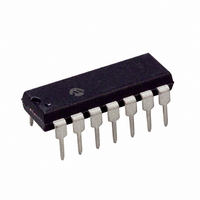MCP2030-I/P Microchip Technology, MCP2030-I/P Datasheet - Page 40

MCP2030-I/P
Manufacturer Part Number
MCP2030-I/P
Description
IC KEYLESS ENTRY AFE 14DIP
Manufacturer
Microchip Technology
Datasheet
1.MCP2030-ISL.pdf
(66 pages)
Specifications of MCP2030-I/P
Rf Type
ISM
Frequency
125kHz
Features
10kbps
Package / Case
14-DIP (0.300", 7.62mm)
Ic Function
Analog Front End Device IC
Supply Voltage Range
2V To 3.6V
Operating Temperature Range
-40°C To +85°C
Digital Ic Case Style
DIP
No. Of Pins
14
Supply Voltage
2V
Leaded Process Compatible
Yes
Rohs Compliant
Yes
Lead Free Status / RoHS Status
Lead free / RoHS Compliant
Available stocks
Company
Part Number
Manufacturer
Quantity
Price
Company:
Part Number:
MCP2030-I/P
Manufacturer:
MICROCHIP
Quantity:
12 000
MCP2030
5.20
The Soft Reset is issued in the following events:
a)
b)
c)
d)
The “Abort” occurs if there is no positive signal
detected at the end of the AGC initialization period
(T
brings the device into a low current Standby mode
operation. The internal circuits that are initialized by the
Soft Reset include:
• Output Enable Filter
• AGC circuits
• Demodulator
• 32 kHz Internal Oscillator
The Soft Reset has no effect on the Configuration register
setup, except for some of the AFE STATUS Register 7
bits. (Register 5-8).
The circuit initialization takes one internal clock cycle
(1/32 kHz = 31.25
modulation transistors between each input and
LCCOM pins are turned-on to discharge any internal/
external parasitic charges. The modulation transistors
are turned-off immediately after the initialization time.
The Soft Reset is executed in Active mode only. It is not
valid in Standby mode.
DS21981A-page 40
AGC
After Power-on Reset (POR),
After Inactivity timer time-out,
If an “Abort” occurs,
After receiving SPI Soft Reset command.
). The Soft Reset initializes internal circuits and
Soft Reset
s). During the initialization, the
5.21
The device demodulates the modulated input signal if
the modulation depth of the input signal is greater than
the minimum requirement that is programmed in
Configuration Register 5 (Register 5-6). Figure 5-5
shows the definition of the modulation depth and
examples. MODMIN<6:5> of the Configuration Register
5 offer four options. They are 60%, 33%, 14% and 6%.
The default setting is 33%.
The purpose of this feature is to enhance the
demodulation integrity of the input signal. The 6%
setting is the best choice for the input signal with weak
modulation depth, which is typically observed near the
high-voltage base station antenna and also at far-
distance from the base station antenna. It gives the
best demodulation sensitivity, but is very susceptible to
noise spikes that can result in a bit detection error. The
60% setting can reduce the bit errors caused by noise,
but gives the least demodulation sensitivity. See
Table 5-3 for minimum modulation depth requirement
settings.
TABLE 5-3:
(Config. Register 5)
Bit 6
MODMIN Bits
0
0
1
1
Minimum Modulation Depth
Requirement for Input Signal
Bit 5
SETTING FOR MINIMUM
MODULATION DEPTH
REQUIREMENT
0
1
0
1
© 2005 Microchip Technology Inc.
Modulation Depth
33% (default)
60%
14%
8%

















